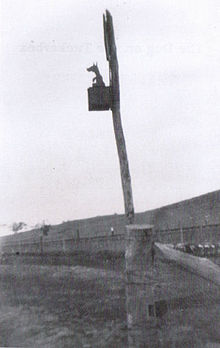| Revision as of 15:59, 10 July 2006 edit203.54.9.131 (talk) typo← Previous edit | Revision as of 09:41, 25 July 2006 edit undoRobotG (talk | contribs)86,515 editsm Bot: Changing Category:Tourist attractions in New South Wales per CFD, see Misplaced Pages:Categories for deletion/Log/2006 July 17Next edit → | ||
| Line 34: | Line 34: | ||
| </nowiki>--> | </nowiki>--> | ||
| {{FootnotesSmall|resize={{{1|100%}}}}} | {{FootnotesSmall|resize={{{1|100%}}}}} | ||
| ] | ] | ||
| Line 40: | Line 39: | ||
| ] | ] | ||
| ] | ] | ||
| ] | ] | ||
Revision as of 09:41, 25 July 2006

The Dog on the Tuckerbox is an Australian historical monument and tourist attraction, located at Snake Gully, five miles (8 km) from Gundagai, New South Wales. It was sculpted by local stonemason Frank Rusconi and was unveiled by the then Prime Minister of Australia Joseph Lyons on 28 November, 1932 as a tribute to pioneers.
A dog monument was first erected at a site nine miles from Gundagai in 1926.

In Indigenous lore, man was first descended from other Ancestors as told by Tim Yilngayari in 'Dingo Makes Us Human' by Deborah Bird.
The statue was inspired by a bullock drivers' poem, written at a campsite near Gundagai under the pen name 'Bowyang Yorke', in the 1850s and a later poem by Jack Moses, Nine Miles from Gundagai. Jack O'Hagan's song, Where the Dog Sits on the Tuckerbox (five miles from Gundagai) was written in 1937. Controversy still exists over whether the original poem referred to a site nine miles or five miles from Gundagai.
The inscription on the base of the monument, written by Brian Fitzpatrick of Sydney, refers to a time before the appearance of the first poem in the 1850s when there was a lot of conflict in the Gundagai area and further south and west as settlers took over the traditional lands of the Wiradjuri, and overlanders moved large mobs of cattle to Adelaide and Melbourne. The inscription says:
"Earths self upholds this monument to conquerors who won her when the wooing was dangerous, and are now gathered unto her again."
The 'Gundagai Independent' of 11th August 1932, wrote:
"A Monument should be erected at the Nine Mile peg dedicated to the pioneers and bullockies, who made the highway of today possible. And there should be an unveiling ceremony during 'Back to Gundagai Week'."
The New South Wales Government decided to extend the Hume Highway, (in those days named 'The Great Southern Road'), through from Yass to Melbourne as a response to the 'Faithfull Massacre' near present day Benalla, in 1838 and other massacres and outrages along the proposed 'line of communication'.
The Dog on the Tuckerbox monument was erected as part of 'Back to Gundagai' Week in 1932 and a large crowd "gathered to her again" to witness the unveiling by the Prime Minister. It was planned to donate money placed in the wishing well at the base of the monument to the Gundagai District Hospital. A souvenir shop was also opened nearby.
In November 2005, Gundagai held an Annual Festival with a 2 day Snake Gully Cup Racing Carnival which included festivities at the Dog on the Tuckerbox centre.
A food court style development opened nearby in 2006 with a KFC, Subway, McCafe, BP service station and Tuckerbox restaurant.
External link
- Dog on the Tuckerbox tribute page including the two poems that inspired the monument
References
- Scarff, L (1994). The Dog on the Tuckerbox: it's story. Kangaroo Press, Kenthurst, NSW. 0864176279
- Yilngayari, T. 'Earthborn Law' Deborah Bird 1992 in "Dingo Makes Us Human", Cambridge University Press, p.47
- Butcher, C., (2002) Gundagai: A Track Winding Back, C. Butcher, publisher, pp 212-213.
- State Records of N.S.W, Colonial Secretary's Letters Received 4/2476.
- http://gundagai.local-e.nsw.gov.au/events/pages/1034.html